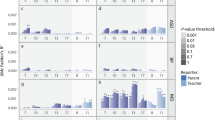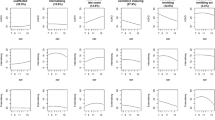Abstract
Bully victimization is a common problem among children with neurodevelopmental disorders, including attention deficit/hyperactivity disorder and autism spectrum disorder. Previous research was mostly cross-sectional and seldom accounted for co-morbid psychopathology, which makes it difficult to draw conclusions about causality and specificity of any association. Using a genetically informative prospective design, we investigated the association between various neurodevelopmental problems (NDPs) in childhood and bully victimization in adolescence, and the relative contributions of genetic and environmental factors to this association. We obtained parent-reports of NDPs at age 9/12 years and self-reported bully victimization at age 15 for 3,921 children participating in the The Child and Adolescent Twin Study in Sweden (CATSS). Structural equation modelling was used to control for NDP co-morbidity and bully victimization at baseline. Cholesky decomposition was used to analyse genetic and environmental contributions to observed associations. Because most of the NDPs were associated to later bully victimization, a common effect of all NDPs was summarized into a general NDP factor. Controlling for this general factor, only problems with social interaction and motor control uniquely predicted subsequent bully victimization in girls. General and unique associations were influenced by both genetic and unique environmental factors. NDPs in general and social interaction and motor problems in particular predicted later bully victimization. The longitudinal design and twin analyses indicated that these associations might be causal. Knowledge of these vulnerabilities may be important when designing risk assessment and prevention strategies.


Similar content being viewed by others
References
Nordhagen R, Nielsen A, Stigum H, Köhler L (2005) Parental reported bullying among Nordic children: a population-based study. Child Care Health Dev 31(6):693–701
Craig W, Harel-Fisch Y, Fogel-Grinvald H, Dostaler S, Hetland J, Simons-Morton B et al (2009) A cross-national profile of bullying and victimization among adolescents in 40 countries. Int J Public Health 54(Suppl 2):216–224
Solberg ME, Olweus D (2003) Prevalence estimation of school bullying with the Olweus Bully/Victim Questionnaire. Aggress Behav 29(3):239–268
Arseneault L, Bowes L, Shakoor S (2009) Bullying victimization in youths and mental health problems: “Much ado about nothing”? Psychol Med 40(05):717–727
Fisher HL, Moffitt TE, Houts RM, Belsky DW, Arseneault L, Caspi A (2012) Bullying victimisation and risk of self harm in early adolescence: longitudinal cohort study. BMJ 26(344):e2683
Hawker DS, Boulton MJ (2000) Twenty years’ research on peer victimization and psychosocial maladjustment: a meta-analytic review of cross-sectional studies. J Child Psychol Psychiatry 41(4):441–455
Copeland WE, Wolke D, Angold A, Costello EJ (2013) Adult psychiatric outcomes of bullying and being bullied by peers in childhood and adolescence. JAMA Psychiatry 70(4):419–426
Kim YS, Leventhal B (2008) Bullying and suicide. A review. Int J Adolesc Med Health 20(2):133–154
Klomek AB, Sourander A, Niemelä S, Kumpulainen K, Piha J, Tamminen T et al (2009) Childhood bullying behaviors as a risk for suicide attempts and completed suicides: a population-based birth cohort study. J Am Acad Child Adolesc Psychiatry 48(3):254–261
Wolke D, Lereya ST, Fisher HL, Lewis G, Zammit S (2014) Bullying in elementary school and psychotic experiences at 18 years: a longitudinal, population-based cohort study. Psychol Med 44(10):2199–2211
Wolke D, Copeland WE, Angold A, Costello EJ (2013) Impact of bullying in childhood on adult health, wealth, crime, and social outcomes. Psychol Sci 19:1958–1970
Cappadocia MC, Weiss JA, Pepler D (2012) Bullying experiences among children and youth with autism spectrum disorders. J Autism Dev Disord 42(2):266–277
Sterzing PR, Shattuck PT, Narendorf SC, Wagner M, Cooper BP (2012) Bullying involvement and autism spectrum disorders: prevalence and correlates of bullying involvement among adolescents with an autism spectrum disorder. Arch Pediatr Adolesc Med 166(11):1058–1064
Holmberg K, Hjern A (2008) Bullying and attention-deficit- hyperactivity disorder in 10-year-olds in a Swedish community. Dev Med Child Neurol 50(2):134–138
Unnever JD, Cornell DG (2003) Bullying, self-control, and ADHD. J Interpers Violence 18(2):129–147
Bejerot S, Edgar J, Humble MB (2011) Poor performance in physical education—a risk factor for bully victimization. A case–control study. Acta Paediatr 100(3):413–419
Bejerot S, Humble MB (2013) Childhood clumsiness and peer victimization: a case–control study of psychiatric patients. BMC Psychiatry 13(1):68
American Psychiatric Association, American Psychiatric Association (2000) Diagnostic and statistical manual of mental disorders: DSM-IV-TR. 4th edn, text revision. American Psychiatric Association, Washington, DC
Gillberg C, Billstedt E (2000) Autism and asperger syndrome: coexistence with other clinical disorders. Acta Psychiatr Scand 102(5):321–330
Murray MJ (2010) Attention-deficit/hyperactivity disorder in the context of autism spectrum disorders. Curr Psychiatry Rep 12(5):382–388
Reiersen AM, Constantino JN, Todd RD (2008) Co-occurrence of motor problems and autistic symptoms in attention-deficit/hyperactivity disorder. J Am Acad Child Adolesc Psychiatry 47(6):662–672
Pettersson E, Anckarsäter H, Gillberg C, Lichtenstein P (2013) Different neurodevelopmental symptoms have a common genetic etiology. J Child Psychol Psychiatry 54(12):1356–1365
Lichtenstein P, Carlström E, Råstam M, Gillberg C, Anckarsäter H (2010) The genetics of autism spectrum disorders and related neuropsychiatric disorders in childhood. Am J Psychiatry 167(11):1357–1363
Posthuma D, Polderman TJC (2013) What have we learned from recent twin studies about the etiology of neurodevelopmental disorders? Curr Opin Neurol 26(2):111–121
Ball HA, Arseneault L, Taylor A, Maughan B, Caspi A, Moffitt TE (2008) Genetic and environmental influences on victims, bullies and bully-victims in childhood. J Child Psychol Psychiatry 49(1):104–112
Shadish WR (2001) Experimental and quasi-experimental designs for generalized causal inference. Houghton Mifflin, Boston
D’Onofrio BM, Lahey BB, Turkheimer E, Lichtenstein P (2013) Critical need for family-based, quasi-experimental designs in integrating genetic and social science research. Am J Public Health 103(Suppl 1):S46–S55
Anckarsäter H, Lundström S, Kollberg L, Kerekes N, Palm C, Carlström E et al (2011) The child and adolescent twin study in Sweden (CATSS). Twin Res Hum Genet Off J Int Soc Twin Stud 14(6):495–508
Larson T, Anckarsäter H, Gillberg C, Ståhlberg O, Carlström E, Kadesjö B et al (2010) The Autism–Tics, AD/HD and other comorbidities inventory (A-TAC): further validation of a telephone interview for epidemiological research. BMC Psychiatry 10(1):1
Larson T, Lundström S, Nilsson T, Selinus EN, Råstam M, Lichtenstein P et al (2013) Predictive properties of the A-TAC inventory when screening for childhood-onset neurodevelopmental problems in a population-based sample. BMC Psychiatry 13:233
Olweus D (1994) Bullying at school: basic facts and effects of a school based intervention program. J Child Psychol Psychiatry 35(7):1171–1190
Olweus D (1996) The revised olweus bully/victim questionnaire. Research Center for Health Promotion, University of Bergen, Bergen
Bowes L, Arseneault L, Maughan B, Taylor A, Caspi A, Moffitt TE (2009) School, neighborhood, and family factors are associated with children’s bullying involvement: a nationally representative longitudinal study. J Am Acad Child Adolesc Psychiatry 48(5):545–553
Cook CR, Williams KR, Guerra NG, Kim TE, Sadek S (2010) Predictors of bullying and victimization in childhood and adolescence: a meta-analytic investigation. Sch Psychol Q 25(2):65–83
Wolke D, Woods S, Stanford K, Schulz H (2001) Bullying and victimization of primary school children in England and Germany: prevalence and school factors. Br J Psychol 92(Pt 4):673–696
StataCorp (2013) Stata Statistical Software: Release 13. StataCorp LP, College Station
Muthén LK, Muthén BO (1998) Mplus User’s Guide, 7th edn. Muthén & Muthén, Los Angeles
Gillberg C (2010) The ESSENCE in child psychiatry: early symptomatic syndromes eliciting neurodevelopmental clinical examinations. Res Dev Disabil 31(6):1543–1551
Crawford AM, Manassis K (2011) Anxiety, social skills, friendship quality, and peer victimization: an integrated model. J Anxiety Disord 25(7):924–931
Egan SK, Perry DG (1998) Does low self-regard invite victimization? Dev Psychol 34(2):299–309
Hebron J, Humphrey N (2014) Exposure to bullying among students with autism spectrum conditions: a multi-informant analysis of risk and protective factors. Autism Int J Res Pract 18(6):618–630
Roekel E, Scholte RHJ, Didden R (2009) Bullying among adolescents with autism spectrum disorders: prevalence and perception. J Autism Dev Disord 40(1):63–73
Storch EA, Larson MJ, Ehrenreich-May J, Arnold EB, Jones AM, Renno P et al (2012) Peer victimization in youth with autism spectrum disorders and co-occurring anxiety: relations with psychopathology and loneliness. J Dev Phys Disabil 24(6):575–590
Sofronoff K, Dark E, Stone V (2011) Social vulnerability and bullying in children with Asperger syndrome. Autism Int J Res Pract 15(3):355–372
Jansen DE, Veenstra R, Ormel J, Verhulst FC, Reijneveld SA (2011) Early risk factors for being a bully, victim, or bully/victim in late elementary and early secondary education. The longitudinal TRAILS study. BMC Public Health 11(1):440
Stephenson EA, Chesson RA (2008) “Always the guiding hand”: parents’ accounts of the long-term implications of developmental co-ordination disorder for their children and families. Child Care Health Dev 34(3):335–343
DeRosier ME (2004) Building relationships and combating bullying: effectiveness of a school-based social skills group intervention. J Clin Child Adolesc Psychol Off J Soc Clin Child Adolesc Psychol Am Psychol Assoc Div 33(1):196–201
Reichow B, Steiner AM, Volkmar F (2012) Social skills groups for people aged 6–21 with autism spectrum disorders (ASD). Cochrane Database Syst Rev 7:CD008511
McMahon CM, Lerner MD, Britton N (2013) Group-based social skills interventions for adolescents with higher-functioning autism spectrum disorder: a review and looking to the future. Adolesc Health Med Ther 4:23–28
Carbone-Lopez K, Esbensen F-A, Brick BT (2010) Correlates and consequences of peer victimization: gender differences in direct and indirect forms of bullying. Youth Violence Juv Justice 8(4):332–350
Bacchini D, Affuso G, Trotta T (2008) Temperament, ADHD and peer relations among schoolchildren: the mediating role of school bullying. Aggress Behav 34(5):447–459
Robinson EB, Lichtenstein P, Anckarsäter H, Happé F, Ronald A (2013) Examining and interpreting the female protective effect against autistic behavior. Proc Natl Acad Sci USA 110(13):5258–5262
Gilman SR, Iossifov I, Levy D, Ronemus M, Wigler M, Vitkup D (2011) Rare de novo variants associated with autism implicate a large functional network of genes involved in formation and function of synapses. Neuron 70(5):898–907
Pierce K, Glad KS, Schreibman L (1997) Social perception in children with autism: an attentional deficit? J Autism Dev Disord 27(3):265–282
Loveland KA, Pearson DA, Tunali-Kotoski B, Ortegon J, Gibbs MC (2001) Judgments of social appropriateness by children and adolescents with autism. J Autism Dev Disord 31(4):367–376
Van Roekel E, Scholte RHJ, Didden R (2010) Bullying among adolescents with autism spectrum disorders: prevalence and perception. J Autism Dev Disord 40(1):63–73
Acknowledgments
The CATSS study was supported by the Swedish Council for Working Life and Social Research, the Research Council of the Swedish National Alcohol Monopoly, the Söderström–Königska Foundation, funds under the ALF agreement and the Swedish Research Council.
Conflict of interest
On behalf of all authors, the corresponding author states that there is no conflict of interest.
Author information
Authors and Affiliations
Corresponding author
Electronic supplementary material
Below is the link to the electronic supplementary material.
Rights and permissions
About this article
Cite this article
Törn, P., Pettersson, E., Lichtenstein, P. et al. Childhood neurodevelopmental problems and adolescent bully victimization: population-based, prospective twin study in Sweden. Eur Child Adolesc Psychiatry 24, 1049–1059 (2015). https://doi.org/10.1007/s00787-014-0658-0
Received:
Accepted:
Published:
Issue Date:
DOI: https://doi.org/10.1007/s00787-014-0658-0




